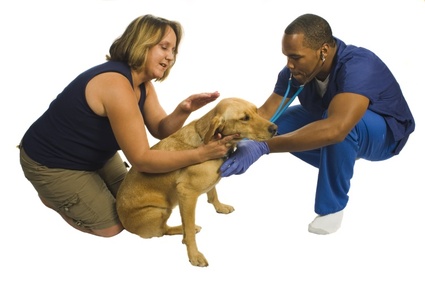Labrador Osteosarcoma - A Dog Bone Cancer
Do you worry about dog bone cancer?
You will if you are a Labrador dog lover or have any other kind of furry four-legged friends at home.
Ever wondered about its health, especially that it’s susceptible to that dreaded disease?a
Labrador osteosarcoma as it’s called in scientific jargon can occur in any dog, and it’s up to the owner to look back, worry and think about his own dog’s health. So what’s dogbone cancer like?
Are there any symptoms? How do you treat it? Read on…

What To Look Out For
Dog bone cancer can occur in bones above the wrist joint (distal radius), near the shoulder, in the lower half of the femur and the upper half of the tibia. It occurs very rarely in pelvic bones, shoulder blades or spinal bones.
The commonest symptoms are lameness and pain. One of the first solid signs of bone cancer can be the acute pain and lameness after a fracture through a cancerous bone.
It could also be due to spread of the metastases or cancer to other organs.
This leads to dogs losing their appetite, a decrease in activity and depression. Symptoms can develop over a short period, although lameness can be persistent resisting the treatment of the injury. Involved areas can sometimes be tender.
Diagnosis
Labrador osteosarcoma is most prevalent in old dogs suffering from arthritis or ligament tears although there can be cases in young dogs too, but they would be diagnosed with ligament problems or a sprain.
Generally lameness in dogs is misdiagnosed as having some other cause, but is later certified as dog bone cancer.
Most bone cancers can be diagnosed by X-ray and treatment plans can be set without further tests. X-rays, especially of the chest and heart should be undertaken to medically assess whether there is any sign of visible lung metastases.
It also takes stock of the heart condition and determines the existence of any other medical problems.
Treatment
The entire diagnostic procedure determines the plan of treatment and the management of pain.
Though in the case of lung metastases, amputation won’t have any long-term medical impact in arresting the disease, some proceed on those lines to control the dogs pain.
The general line of medical advice is to go in for amputation or resection where possible and combine this with chemotherapy or ray-treatment. This medical methodology of combined treatment, using amputation with chemotherapy, statistically shows the largest survival rates.
Aftercare
As treatment proceeds, specimens obtained after amputation should be sent for pathological diagnosis. Sophisticated tests identify cell type and confirm the type of dog-bone cancer. This information determines what chemotherapy drugs will be used. Drugs commonly used are Doxorubicin, Cisplatin, or Carboplatin.
Summary
Dog-bone cancer or Labrador osteosarcom can be the worst thing to happen to your dog.
Early diagnosis can help minimize the suffering of your pet. Once an X-ray has been done confirming cancer, it isn’t necessary to do a bone biopsy, another painful diagnostic tool.
Treatment can begin immediately and may entail surgery for amputation followed by chemotherapy. Drugs should be administered when required or advised by your vet.
Related Articles
Detailed Overview Of Dog Bone Cancer
Canine Skin Cancer
Dog Breast Cancer
Labrador Retriever Health